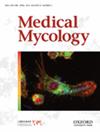De novo genome sequencing and comparative analyses of the clinically relevant species Mucor ardhlaengiktus, Mucor circinelloides, Mucor griseocyanus, and Mucor janssenii.
IF 2.3
3区 医学
Q3 INFECTIOUS DISEASES
引用次数: 0
Abstract
Mucormycosis is predominantly caused by members of the genera Lichtheima, Mucor, and Rhizopus. Here, we report the genome assemblies and comparative analyses of the clinically relevant species Mucor ardhlaengiktus (CBS 210.80), Mucor circinelloides (CBS 195.68), Mucor janssenii (CBS 205.68), and Mucor griseocyanus (CBS 116.08) to enable molecular analyses.
临床相关种硬毛霉(Mucor ardhlaengiktus)、环形毛霉(Mucor circinelloides)、灰青毛霉(Mucor griseocyanus)和杨氏毛霉(Mucor janssenii)的从头基因组测序和比较分析。
毛霉病主要由毛霉属、毛霉属和根霉属的成员引起。在这里,我们报告了临床相关物种Mucor ardhlaengiktus (CBS 210.80)、Mucor circinelloides (CBS 195.68)、Mucor janssenii (CBS 205.68)和Mucor griseocyanus (CBS 116.08)的基因组组合和比较分析,以便进行分子分析。
本文章由计算机程序翻译,如有差异,请以英文原文为准。
求助全文
约1分钟内获得全文
求助全文
来源期刊

Medical mycology
医学-兽医学
CiteScore
5.70
自引率
3.40%
发文量
632
审稿时长
12 months
期刊介绍:
Medical Mycology is a peer-reviewed international journal that focuses on original and innovative basic and applied studies, as well as learned reviews on all aspects of medical, veterinary and environmental mycology as related to disease. The objective is to present the highest quality scientific reports from throughout the world on divergent topics. These topics include the phylogeny of fungal pathogens, epidemiology and public health mycology themes, new approaches in the diagnosis and treatment of mycoses including clinical trials and guidelines, pharmacology and antifungal susceptibilities, changes in taxonomy, description of new or unusual fungi associated with human or animal disease, immunology of fungal infections, vaccinology for prevention of fungal infections, pathogenesis and virulence, and the molecular biology of pathogenic fungi in vitro and in vivo, including genomics, transcriptomics, metabolomics, and proteomics. Case reports are no longer accepted. In addition, studies of natural products showing inhibitory activity against pathogenic fungi are not accepted without chemical characterization and identification of the compounds responsible for the inhibitory activity.
 求助内容:
求助内容: 应助结果提醒方式:
应助结果提醒方式:


